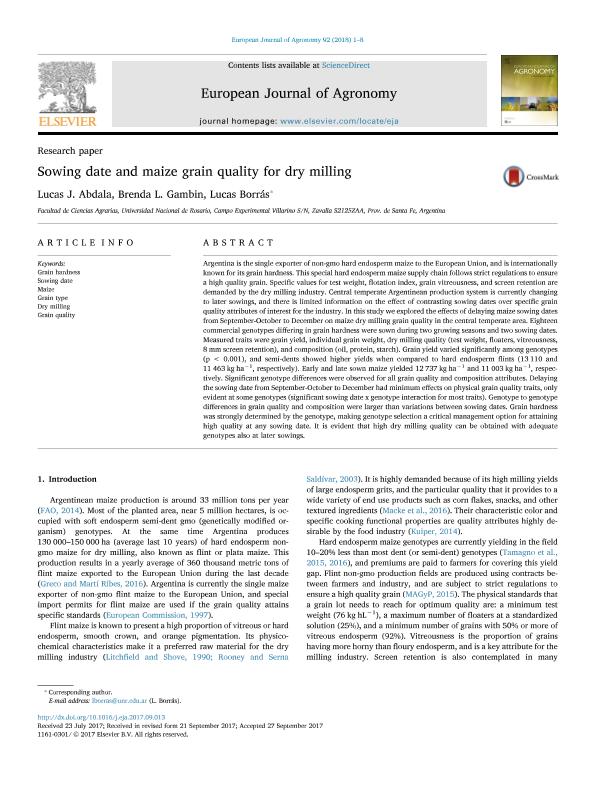Mostrar el registro sencillo del ítem
dc.contributor.author
Abdala Alonso, Lucas Jorge

dc.contributor.author
Gambin, Brenda Laura

dc.contributor.author
Borras, Lucas

dc.date.available
2020-01-03T20:04:48Z
dc.date.issued
2018-01
dc.identifier.citation
Abdala Alonso, Lucas Jorge; Gambin, Brenda Laura; Borras, Lucas; Sowing date and maize grain quality for dry milling; Elsevier Science; European Journal of Agronomy; 92; 1-2018; 1-8
dc.identifier.issn
1161-0301
dc.identifier.uri
http://hdl.handle.net/11336/93482
dc.description.abstract
Argentina is the single exporter of non-gmo hard endosperm maize to the European Union, and is internationally known for its grain hardness. This special hard endosperm maize supply chain follows strict regulations to ensure a high quality grain. Specific values for test weight, flotation index, grain vitreousness, and screen retention are demanded by the dry milling industry. Central temperate Argentinean production system is currently changing to later sowings, and there is limited information on the effect of contrasting sowing dates over specific grain quality attributes of interest for the industry. In this study we explored the effects of delaying maize sowing dates from September-October to December on maize dry milling grain quality in the central temperate area. Eighteen commercial genotypes differing in grain hardness were sown during two growing seasons and two sowing dates. Measured traits were grain yield, individual grain weight, dry milling quality (test weight, floaters, vitreousness, 8 mm screen retention), and composition (oil, protein, starch). Grain yield varied significantly among genotypes (p < 0.001), and semi-dents showed higher yields when compared to hard endosperm flints (13 110 and 11 463 kg ha−1, respectively). Early and late sown maize yielded 12 737 kg ha−1 and 11 003 kg ha−1, respectively. Significant genotype differences were observed for all grain quality and composition attributes. Delaying the sowing date from September-October to December had minimum effects on physical grain quality traits, only evident at some genotypes (significant sowing date x genotype interaction for most traits). Genotype to genotype differences in grain quality and composition were larger than variations between sowing dates. Grain hardness was strongly determined by the genotype, making genotype selection a critical management option for attaining high quality at any sowing date. It is evident that high dry milling quality can be obtained with adequate genotypes also at later sowings.
dc.format
application/pdf
dc.language.iso
eng
dc.publisher
Elsevier Science

dc.rights
info:eu-repo/semantics/openAccess
dc.rights.uri
https://creativecommons.org/licenses/by-nc-nd/2.5/ar/
dc.subject
DRY MILLING
dc.subject
GRAIN HARDNESS
dc.subject
GRAIN QUALITY
dc.subject
GRAIN TYPE
dc.subject
MAIZE
dc.subject
SOWING DATE
dc.subject.classification
Agricultura

dc.subject.classification
Agricultura, Silvicultura y Pesca

dc.subject.classification
CIENCIAS AGRÍCOLAS

dc.title
Sowing date and maize grain quality for dry milling
dc.type
info:eu-repo/semantics/article
dc.type
info:ar-repo/semantics/artículo
dc.type
info:eu-repo/semantics/publishedVersion
dc.date.updated
2019-10-23T20:51:05Z
dc.journal.volume
92
dc.journal.pagination
1-8
dc.journal.pais
Países Bajos

dc.journal.ciudad
Amsterdam
dc.description.fil
Fil: Abdala Alonso, Lucas Jorge. Universidad Nacional de Rosario. Facultad de Ciencias Agrarias. Cátedra de Cultivo Extensivos Cereales y Oleaginosas; Argentina. Consejo Nacional de Investigaciones Científicas y Técnicas. Centro Científico Tecnol.conicet - Rosario. Unidad de Direccion; Argentina
dc.description.fil
Fil: Gambin, Brenda Laura. Universidad Nacional de Rosario. Facultad de Ciencias Agrarias. Cátedra de Cultivo Extensivos Cereales y Oleaginosas; Argentina. Consejo Nacional de Investigaciones Científicas y Técnicas. Centro Científico Tecnológico Conicet - Rosario. Instituto de Investigaciones en Ciencias Agrarias de Rosario. Universidad Nacional de Rosario. Facultad de Ciencias Agrarias. Instituto de Investigaciones en Ciencias Agrarias de Rosario; Argentina
dc.description.fil
Fil: Borras, Lucas. Consejo Nacional de Investigaciones Científicas y Técnicas. Centro Científico Tecnológico Conicet - Rosario. Instituto de Investigaciones en Ciencias Agrarias de Rosario. Universidad Nacional de Rosario. Facultad de Ciencias Agrarias. Instituto de Investigaciones en Ciencias Agrarias de Rosario; Argentina. Universidad Nacional de Rosario. Facultad de Ciencias Agrarias. Cátedra de Cultivo Extensivos Cereales y Oleaginosas; Argentina
dc.journal.title
European Journal of Agronomy

dc.relation.alternativeid
info:eu-repo/semantics/altIdentifier/doi/http://dx.doi.org/10.1016/j.eja.2017.09.013
dc.relation.alternativeid
info:eu-repo/semantics/altIdentifier/url/https://www.sciencedirect.com/science/article/pii/S1161030117301430
Archivos asociados
